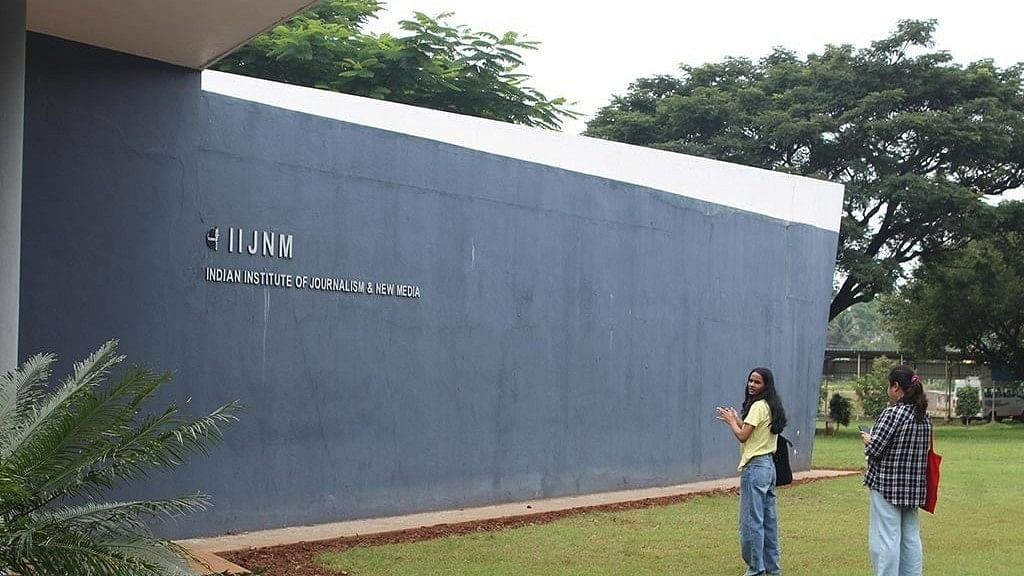
IIJNM, founded in 2000 and located in Kumbalgodu, announced last week that it is winding up its operations.
Credit: iijnm.org
The Indian Institute of Journalism and New Media (IIJNM) will no longer be offering journalism programmes. Located in Kumbalgodu, it is the latest journalism and media centre to down its shutters.
Convergence Institute of Media Management and IT Studies (Commits), Bengaluru, shut down last year. Asian College of Journalism moved from Bengaluru to Chennai in 2000.
K Sai Prasad, who was academic dean and professor of marketing communication at Commits, says journalism and media jobs shrank after the Covid-19 pandemic.
During the pandemic, a number of newspapers reduced their pages, and journalists lost their jobs.
“People latched on to social media and started generating their own content and the influencer economy took off,” he says.
Habits of students changed, and “they no longer felt the need to go to an institution to learn about media”.
“After colleges got back to normal schedules, there was a demand to integrate technology with the curriculum,” says Prasad, current dean and professor, College of Journalism Media and Communication (CJMC), Dayananda Sagar University.
“Jobs became more important than education. Many like Barkha Dutt and Faye D’Souza who youngsters idolised had moved online,” he says.
Though CJMC’s permitted student capacity is 60, they used to get about 40 admissions till 2019. “The numbers dwindled to 30 after that, and in 2023, they dropped to 16. This coincided with the general decline of admissions across city and state colleges, especially during and after the pandemic,” he says.
Centres that have survived offer journalism as part of humanities and liberal arts courses, Prasad says.
Commits, which offered two two-year programmes, would get around 50 students till 2019. This dipped to 18, 19, and nine students in the following years. “A one-year diploma was introduced, which lost students by 2019,” he adds.
Commits’ two-year programme cost Rs 5 lakh (including hostel charges), and the one-year programme about Rs 2.5 lakh. At CJMC, the undergraduate course costs Rs 1.2 lakh per year.
‘Job denigrated’
Former journalist John Thomas, who once headed IIJNM, says many old students contacted him on hearing about the institute shutting down.
“There has been a significant fall in the quality of applicants for journalism in specialised J-schools such as IIJNM,” he says.
More people with no formal training are using their mobile phones and posting ‘stories’ online, but a bigger concern is the deliberate denigration of journalists and journalism, he says.
When journalists who write stories critical of the establishment are branded anti-national, such a fall is inevitable, he says. Thomas adds that the pandemic and the lifestyle restrictions that came with it in March 2020 also affected media economics. “Such business disruption contributed to shortages of jobs, revenue and advertisements, and the spirit in which journalism pursued was diminished,” he observes.
When students pay for a specialised course, their salary expectations are proportionately higher. The market is not in a position to meet them, he explains.
Timothy Franklyn, founder of National School of Journalism (NSoJ), believes the decline of dedicated journalism schools offering postgraduate diploma courses is due to change in student preferences after the pandemic.
NSoJ, which started with a postgraduate diploma, introduced an undergraduate programme in 2018-19. A four-year journalism honours programme was introduced in 2021, after the National Education Policy (NEP) was announced.
“However, the reversal of NEP by the state government led to a revival of the triple-major course,” Franklyn says. The one-year diploma that usually takes 20 students is seeing a low turnout now. NSoJ is contemplating introducing an MA instead of the postgraduate diploma.
On the other side
Fr Richard Rego, dean of the School of Communication and Media Studies, St Joseph’s University, says the situation is not so bleak. Five programmes run by the university — three undergraduate and two postgraduate — are seeing increased interest, he says. The annual fees range from Rs 80,000 to Rs 1 lakh. “Our masters’ programme sees more students now. For our undergraduate programmes, we used to receive 100 applicants for 50 seats. That has gone up to 200-300 applicants now,” he adds.
In some of the centres that shut, the fee for a one-year course was Rs 3.5 to Rs 5 lakh. That is deterring students, he believes. Journalist salaries don’t match the fees, he surmises. “In the last decade, a lot of media courses without good staff were introduced,” says Rego.